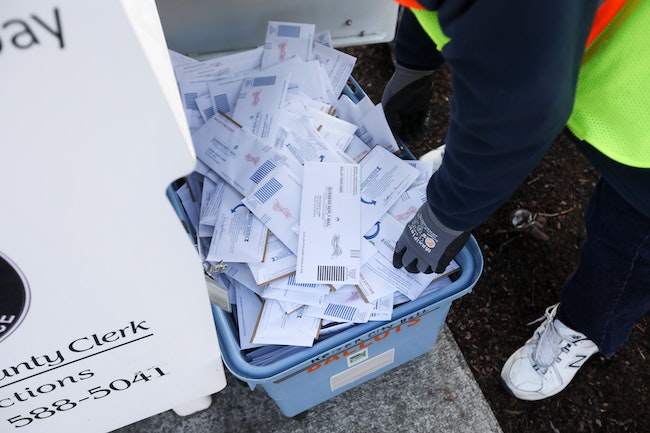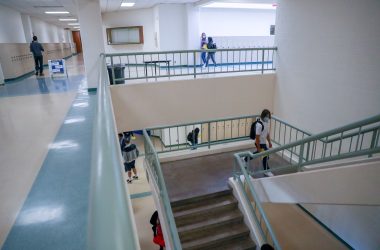
Elections worker Steve Bauman collect ballots from a drop box in Keizer on Thursday, October 23. (Amanda Loman/Salem Reporter)
In Marion County three out of four registered voters cast ballots in the 2016 election, but there are disparities within the county of who turns out in higher numbers. In Polk County, eight in ten registered voters cast a ballot four years ago.
The precincts with the highest returns are further from the Interstate, have higher median incomes and more homeowners.
With just days until the 2020 election, early ballot returns are running strongly ahead of four years ago, and that could accentuate a rural-city split that’s particularly evident in voting patterns in Marion County.
Michael Slater, a local activist who used to work for a voting rights nonprofit, said the factors that generally provide the best guide to who will vote are education, age, marital status, homeownership and length of residence.
While those are the typical metrics, Slater said views on President Donald Trump could be a more dominant indicator of who votes.
“If I were looking at the demographics of an area, I would say ‘what is the marriage rate?’” he said. “It’s unusual now because everybody has an opinion on Donald Trump.”
He said one of the reasons people don’t vote is that they don’t see a difference between Democrats and Republicans. The least engaged in voting are typically those who live alone in rentals.
“The more you feel connected with the community, the more you can see how the stakes matter,” he said.
In the last presidential election, Salem’s more affluent neighborhoods in south Salem voted at a rate 10 to 20 percentage points higher than their counterparts in north and east Salem.
Precincts that touch Interstate 5 in Salem typically saw lower turnout four years ago, in the 50% and 60% range.
The precinct that surrounds Costco, from Highway 22 to State Street and 25th Street to Interstate 5, saw the lowest turnout in Marion County in 2016, with half of registered voters returning ballots.
By contrast, the county’s larger precincts in south Salem saw returns in the 80% range.
One of the higher turnout precincts is an area along River Road circling Minto Brown Island Park to the north and bordering Illahe Hills Country Club to the south. There 89% of voters cast ballots in 2016.
The county’s overall voter participation was 77%. The state rate was 80%.
Jeff Heyen, chair of the Marion County Republicans, said there’s a correlation between socioeconomic status and turnout.
Heyen said campaigns assess voter turnout when determining where to focus their resources. But he said it’s not just voting numbers that politicians are looking at. Those who are putting money behind a candidate have to determine if it’s a winnable seat.
“The parties do that as well when we’re trying to figure out who to support,” Heyen said. “Everybody’s playing the cards trying to figure it all out.”
Southeast Salem’s ward recorded the highest turnout of any in the May primary election, where turnout is usually much lower than a general election. In Ward 7, half of all registered voters cast ballots. By contrast, north Salem had the lowest turnout in the May primary with one in four voters casting ballots.
In west Salem, three precincts saw voter returns from 44% to 48% in May. But precinct 140, which surrounds Wallace Marine Park and runs from Orchard Heights Road to the Willamette River, saw the lowest turnout at 34%. That area contains many apartment complexes.
Overall, Polk County posted a 79.9% voter participation in 2016.
Evan Sorce, chair of the Marion County Democrats, said Marion County is following a trend seen across the country, where suburban women “are seeing the president act the way he’s acting and taking it out on Republicans up and down the ticket.”
He said areas that are traditionally suburban and conservative are moving to the left.
Sorce said the difficulty the Democratic party faces is getting registered voters to turn out for the election, especially in areas with low voter turnout like northeast Salem and House District 22, a line extending from north Salem to Woodburn.
“If you look at some of the barriers that we have for families and communities in northeast Salem, there are less drop boxes. It’s harder for people to get to the drop boxes,” Sorce said.
In north Salem, there are drop boxes at the Roth’s Fresh Market on 4746 Portland Rd. N.E. in and at Marion County Public Works on 5155 Silverton Rd. N.E. Near east Salem, there’s a drop box at Marion County Public Health on 3180 Center St. N.E.
Heyen said there are more progressive-minded people in the area than there used to be but pointed out that Marion County voted for Trump in 2016.
In 2016, 48% of Marion County voted for Trump, compared to 44% for Clinton. Polk County also voted for Trump in 2016 with 47% voting for him and 40% voting for Clinton.
Countywide, the number registered as Democrats or Republicans is nearly equal, with 63,861 Republicans to 63,940 Democrats. The share of nonaffiliated voters has grown over the years, and now make up the largest share of voters in the county with 73,032.
In Polk County, Republicans outnumber nonaffiliated voters by a small margin, both have more than 19,000. There are 17,722 registered Democrats in Polk County.
The rise of nonaffiliated voters can be traced back to the state’s “motor voter” law which automatically registers eligible Oregonians as nonaffiliated when they register at the DMV.
SUPPORT ESSENTIAL REPORTING FOR SALEM – A subscription starts at $5 a month for around-the-clock access to stories and email alerts sent directly to you. Your support matters. Go HERE.
Have a tip? Contact reporter Saphara Harrell at 503-549-6250, [email protected] or @daisysaphara.









